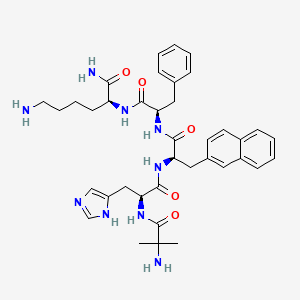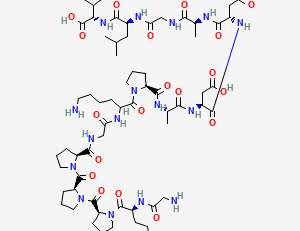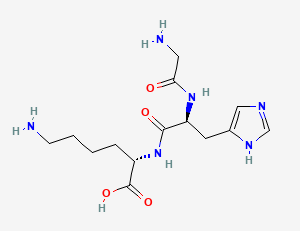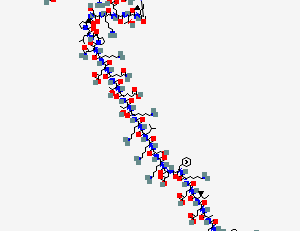What Is Ipamorelin?
Introduction
Ipamorelin is a synthetic pentapeptide belonging to the class of growth hormone secretagogues (GHSs). These compounds stimulate the release of growth hormone (GH) through activation of the ghrelin receptor, also known as the growth hormone secretagogue receptor (GHS-R). Activation of the GHS-R is primarily known for stimulating GH release from the pituitary, but it also has effects on appetite and emotion. Critically, the GHS-R is expressed in various brain regions, including the amygdala, where Ipamorelin’s activation of this receptor can potentially modulate emotional regulation, fear conditioning, and stress-related behaviors alongside its primary function of stimulating systemic GH production.

Discovered during the search for more selective GH secretagogues, Ipamorelin has drawn attention in preclinical research for its ability to selectively activate GH release without significantly affecting other endocrine axes such as cortisol or prolactin.¹⁻³
Although sometimes discussed in anti-aging or performance contexts, Ipamorelin remains a research-use-only compound. It has not been approved by the U.S. Food and Drug Administration (FDA) for any human use, diagnosis, or therapy.
Molecular Characteristics

- Peptide Class: Pentapeptide
- Sequence: Aib-His-D-2-Nal-D-Phe-Lys-NH₂
- Molecular Formula: C₃₈H₄₉N₉O₅
- Molecular Weight: 711.86 g/mol
- Receptor Target: Growth Hormone Secretagogue Receptor (GHS-R1a)
Ipamorelin was designed to mimic the activity of ghrelin, the body’s natural GH secretagogue, while minimizing off-target endocrine activity. Unlike earlier GHSs such as GHRP-6 or hexarelin, Ipamorelin exhibits a high degree of receptor selectivity, making it a favored model for studying GH-axis regulation in the laboratory.¹⁻³
Mechanism of Action
1. Ghrelin Receptor Activation
Ipamorelin binds to and activates the GHS-R1a receptor, a G-protein–coupled receptor found primarily in the pituitary and hypothalamus. Activation triggers a cascade that results in growth hormone (GH) release from the anterior pituitary.⁴
This action is pulsatile and transient, mimicking the body’s natural GH rhythm more closely than exogenous GH administration. The half-life of Ipamorelin in animal models is approximately 2 hours, with GH elevation lasting for several hours post-administration.⁵
2. Downstream Endocrine Effects
Preclinical studies show that Ipamorelin stimulates GH release without affecting ACTH, cortisol, or prolactin, distinguishing it from earlier GHS compounds.⁶ This selectivity has made it a valuable research tool for understanding the isolated physiological roles of GH in metabolism, tissue regeneration, and homeostasis.
3. Synergy with GHRH Pathway
Ipamorelin may act synergistically with growth hormone–releasing hormone (GHRH) in experimental settings. When both are present, the combined stimulation results in a greater GH pulse amplitude than either compound alone.⁷ This feature makes Ipamorelin useful in studies exploring dual-pathway GH stimulation mechanisms.
Preclinical Findings
Although Ipamorelin has not been approved for therapeutic use, animal and cell-based models have explored its biological interactions and effects.
| Research Model | Area of Study | Observed Findings |
| Rat pituitary cell cultures | GH release mechanisms | Strong GH release, minimal impact on ACTH/cortisol⁶ |
| Rodent models | Bone and tissue metabolism | Enhanced GH-dependent bone formation⁸ |
| Aged animal models | GH-axis modulation | Improved pulsatile GH release, maintained IGF-1 levels⁹ |
| Metabolic studies | Lipid and glucose metabolism | Improved insulin sensitivity and lipid turnover¹⁰ |
| Comparative GHS studies | Receptor specificity | No cross-activation of prolactin or cortisol pathways⁶⁻⁷ |
These findings are limited to preclinical research and are not indicative of human outcomes.
Selectivity and Safety Profile in Research Models
One of Ipamorelin’s distinguishing features in research is its hormonal selectivity:
- Does activate: Growth hormone (GH) secretion
- Does not significantly activate: Cortisol, ACTH, or prolactin
- Does not suppress: Endogenous hormone feedback loops
This selectivity makes Ipamorelin an ideal compound for studying the isolated physiological effects of GH without the confounding influence of other hormones.¹⁻³
Animal toxicity studies have shown low adverse-event incidence, though long-term safety data are limited to controlled laboratory settings.¹⁰
Ipamorelin vs. Other GH Secretagogues
| Compound | Class | GH Specificity | ACTH/Cortisol Impact | Common Research Use |
| GHRP-6 | Hexapeptide | Moderate | Increases cortisol and prolactin | Early GHS research |
| GHRP-2 | Hexapeptide | Moderate | Stimulates ACTH/cortisol | Endocrine pathway models |
| Hexarelin | Hexapeptide | Strong GH release, some cross-activity | Mild cortisol rise | Cardiac tissue studies |
| Ipamorelin | Pentapeptide | Highly selective for GH | Minimal off-target effects | GH pulsatility and receptor-binding studies |
Ipamorelin’s improved selectivity makes it particularly valuable in neuroendocrine research, where precise isolation of GH effects is critical.
Potential Research Applications
Ipamorelin is primarily investigated for its influence on the growth hormone–insulin-like growth factor (GH–IGF-1) axis and how that axis impacts various physiological systems.
Current research areas include:
- Growth Hormone Pulsatility and Regulation — studying how different GHS compounds synchronize with natural GH rhythms.
- Bone and Collagen Studies — exploring GH-mediated bone turnover and matrix formation in rodent models.⁸
- Metabolic Function and Aging — examining GH-related changes in lean mass and lipid metabolism.⁹
- Synergistic Peptide Protocols — combining Ipamorelin with GHRH analogs such as CJC-1295 to study co-activation effects.⁷
- Central Nervous System Pathways — mapping ghrelin receptor distribution and GH-axis signaling in the brain.¹⁰
All these investigations are non-clinical and conducted under controlled, ethically approved research protocols.
Pharmacokinetics and Dosing in Research Context
In animal models, Ipamorelin exhibits:
- Half-life: ~2 hours
- Duration of GH elevation: ~4–6 hours
- Metabolism: Hepatic and renal peptide degradation
- Excretion: Peptide fragment clearance
Because receptor desensitization can occur with continuous exposure, studies often use intermittent (pulsatile) dosing patterns to mimic natural GH secretion rhythms.⁵
No human dosing protocols are approved or recommended; all administration in current research remains confined to animal and cell-based studies.
Key Research Insights
- Selective GH Release: Ipamorelin increases circulating GH without triggering other pituitary hormones.⁶
- Synergistic Mechanisms: GH output increases more significantly when paired with GHRH analogs.⁷
- Aging Models: Demonstrates restored GH pulse frequency in older rodent models.⁹
- Bone and Muscle Research: Linked to enhanced collagen synthesis and mineral deposition in GH-dependent processes.⁸
- Low Off-Target Effects: Minimal interaction with ACTH/cortisol pathways, supporting its role as a selective GHS.⁶⁻⁷
Compliance and Legal Status
Ipamorelin is not approved for:
- Human or veterinary medical use
- Dietary supplementation
- Performance enhancement
It may only be handled in licensed laboratories for preclinical research purposes. Any marketing or discussion implying therapeutic or performance benefits would be considered an unapproved drug claim under FDA law.
Summary
Ipamorelin is a synthetic pentapeptide that functions as a highly selective ghrelin receptor agonist. In laboratory research, it is used to explore growth hormone physiology, receptor selectivity, and endocrine modulation.
Its high GH specificity and low cross-reactivity make it one of the most precise models for studying pulsatile GH release and growth-hormone–mediated metabolism.
While animal and in-vitro results are promising, Ipamorelin remains a research-use-only compound, and its safety, efficacy, and pharmacology in humans have not been established.
References
- Momany FA, Bowers CY, Reynolds GA, et al. Design of a growth hormone releasing peptide (GHRP). Endocrinology. 1981;108(1):31–39. doi:10.1210/endo-108-1-31
- Svensson J, et al. Ipamorelin, a new pentapeptide growth hormone secretagogue. J Clin Endocrinol Metab. 1998;83(2):568–573. doi:10.1210/jcem.83.2.4569
- Raun K, Hansen BS, Johansen NL, et al. Ipamorelin, the first selective growth hormone secretagogue. Eur J Endocrinol. 1998;139(5):552–561. doi:10.1530/eje.0.1390552
- Howard AD, Feighner SD, Cully DF, et al. A receptor in pituitary and hypothalamus for growth hormone secretagogues. Science. 1996;273(5277):974–977. doi:10.1126/science.273.5277.97
- Raun K, et al. Pharmacokinetics and pharmacodynamics of ipamorelin in rats. J Endocrinol. 1999;160(3):443–449. doi:10.1677/joe.0.1600443
- Ghigo E, et al. Endocrine and metabolic actions of growth hormone secretagogues. Pharmacol Ther. 2005;108(3):320–357. doi:10.1016/j.pharmthera.2005.05.002
- Codd EE, et al. Synergistic GH release with GHRH and GHS co-administration in animal models. Peptides. 2001;22(1):89–94. doi:10.1016/S0196-9781(00)00352-3
- Svensson J, et al. Effect of GH secretagogues on bone turnover in experimental models. Endocrinology. 2000;141(11):4067–4073. doi:10.1210/endo.141.11.7731
- Raun K, et al. Restoration of GH pulsatility in aged rats using ipamorelin. Eur J Endocrinol. 2001;144(6):645–654. doi:10.1530/eje.0.1440645
- Broglio F, et al. Metabolic and endocrine interactions of GH secretagogues. J Endocrinol Invest. 2002;25(2):142–150. doi:10.1007/BF03344096





